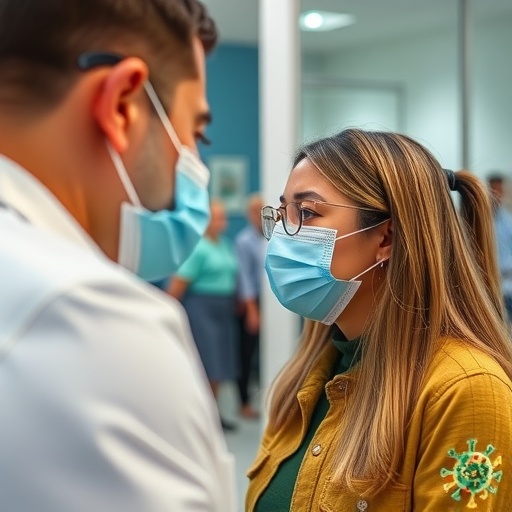The COVID-19 pandemic has dramatically altered many aspects of daily life, with significant repercussions in mental health care practices. Among the various adaptations necessitated by the global health crisis, the use of infection prevention measures in psychotherapy settings has emerged as a critical topic for both therapists and patients alike. The study conducted by Aoki, Ono, and Fukui provides valuable insights into how psychotherapists perceive these measures and their broader implications for face-to-face therapy.
As the pandemic unfolded, mental health professionals faced a dual challenge: the need to continue providing essential care while ensuring the safety of their clients and themselves. The implementation of personal protective equipment (PPE), social distancing guidelines, and sanitization protocols were among the most visible alterations in therapy settings. The therapists’ perceptions of these measures are shaped not only by their experiences during the pandemic but also by their clinical intuitions about the therapeutic process. Understanding how these perceptions influence psychotherapy can help refine practices in a post-pandemic world.
Furthermore, the psychological impact of the pandemic itself cannot be understated. Increased levels of anxiety, depression, and social isolation created an urgent need for accessible mental health services. Therapists had to grapple with the shifting landscapes of their patients’ emotional needs while adapting to new operational guidelines. The therapists noted that these infection protocols sometimes interfered with the therapeutic alliance—an essential component of effective therapy. The intimacy and non-verbal cues that often characterize face-to-face interactions could be diminished or altered through physical barriers such as masks.
In the context of therapy, non-verbal communication plays a crucial role in building rapport and establishing trust between therapist and client. The researchers found that many therapists reported feeling that their ability to read subtle cues—like facial expressions or body language—was constrained when clients wore masks. This limitation, they argued, might hinder the efficacy of therapy, as understanding a client’s emotional state deeply influences a therapist’s approach. Thus, the balance between maintaining safety and preserving the therapeutic alliance became a pressing concern.
Moreover, the shifting modalities of therapy have sparked debate and inquiry into the effectiveness of teletherapy versus traditional face-to-face interactions. Many therapists transitioned to virtual platforms amidst the pandemic, which prompted questions around patient satisfaction, engagement, and overall therapeutic outcomes. The study highlighted therapists’ mixed feelings about teletherapy as a substitute for in-person sessions. Some embraced technological advancements, while others expressed concerns about missing vital nuances that are easier to capture in person.
Client preferences also emerged as a crucial variable. Through interviews, therapists revealed that responses varied, with some clients feeling comfortable returning to in-person therapy despite prevailing health risks, while others preferred to remain in the virtual realm. The initial anxiety surrounding in-person sessions often led to profound discussions about risk, safety, and vulnerability in the therapeutic context, revealing the intricate dynamics that accompany therapy in a pandemic landscape.
As the pandemic continues to evolve, so does the dialogue surrounding mental health practices. What has become increasingly evident is the necessity for adaptable strategies that consider both client and therapist perspectives. The research findings advocate for ongoing discussions regarding best practices in infection prevention, highlighting that while physical safety is paramount, emotional safety should also be prioritized.
The implications of these findings extend beyond the current crisis, informing future strategies in psychotherapy. It raises questions about the persistence of infection prevention protocols in continued practice and how therapists can innovate to create safe, supportive environments for clients. Future research should explore longitudinal outcomes of therapy conducted under these adjusted conditions to fully understand their implications.
Interestingly, the therapists involved in the study indicated that some of these safety measures could be leveraged to enhance the therapeutic experience in more conventional circumstances. For example, certain protocols, like clearer boundaries on session timeframes, have the potential to be retained. As practitioners reflect on their experiences during this challenging time, integrating lessons learned could foster healthier therapeutic dynamics moving forward.
This exploration into the perceptions of therapists about COVID-19 infection protocols can serve as a springboard for further research initiatives within clinical psychology. It underscores the importance of understanding therapist well-being alongside the client experience, reminding us that care extends both ways. By prioritizing the mental health of practitioners, we can improve the overall quality of therapy, even in crisis situations.
In conclusion, the insights shared by Aoki, Ono, and Fukui shine a critical spotlight on the intersection of mental health care and public health considerations. The pandemic may have upended traditional practices in therapy, but it has also offered an opportunity for growth, adaptation, and improved understanding of how to balance safety with the fundamental elements of the therapeutic process. As mental health professionals navigate these complexities, it is vital to remain open to evolving practices that will support not only their clients but their own well-being as well.
The future of psychotherapy will likely be shaped by these experiences, creating opportunities for innovations that could redefine how care is delivered in the years to come. By fostering a culture of adaptability, understanding, and empathy, practitioners can rise to meet the challenges presented by the pandemic and beyond, ensuring that mental health care remains robust and responsive in an ever-changing world.
Subject of Research: The impact of COVID-19 infection prevention measures on face-to-face psychotherapy.
Article Title: Psychotherapists’ perceptions of the impact of COVID-19 infection prevention measures on face-to-face psychotherapy.
Article References:
Aoki, S., Ono, S. & Fukui, H. Psychotherapists’ perceptions of the impact of COVID-19 infection prevention measures on face-to-face psychotherapy.
Discov Psychol 5, 134 (2025). https://doi.org/10.1007/s44202-025-00474-w
Image Credits: AI Generated
DOI:
Keywords: COVID-19, psychotherapy, infection prevention, therapist perceptions, mental health.




